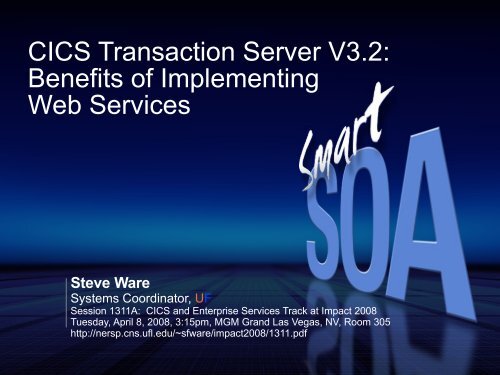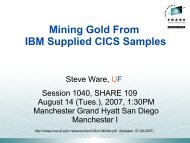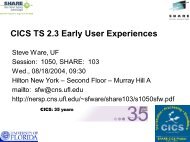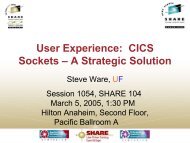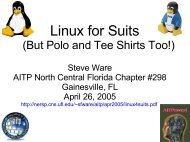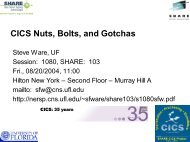CICS - University of Florida
CICS - University of Florida
CICS - University of Florida
Create successful ePaper yourself
Turn your PDF publications into a flip-book with our unique Google optimized e-Paper software.
<strong>CICS</strong> Transaction Server V3.2:<br />
Benefits <strong>of</strong> Implementing<br />
Web Services<br />
Steve Ware<br />
Systems Coordinator, UF<br />
Session 1311A: <strong>CICS</strong> and Enterprise Services Track at Impact 2008<br />
Tuesday, April 8, 2008, 3:15pm, MGM Grand Las Vegas, NV, Room 305<br />
http://nersp.cns.ufl.edu/~sfware/impact2008/1311.pdf
Abstract<br />
This session presents a case study demonstrating<br />
how a customer has deployed the IBM <strong>CICS</strong>®<br />
Transaction Server for z/OS® Version 3.2 as a<br />
core feature <strong>of</strong> their service oriented architecture<br />
(SOA) environment. Session attendees will<br />
discover how this customer streamlined their<br />
business process, reused their existing resources,<br />
and integrated with new and existing business<br />
processes.<br />
IBM Impact 2008, Steve Ware, UF 2
Disclaimer<br />
Standard disclaimers apply. Any opinions expressed are the<br />
opinion <strong>of</strong> the author only.<br />
Any mentioned brand names, trademarks, registered<br />
trademarks, service marks, etc., are the exclusive property <strong>of</strong><br />
their owners.<br />
No warranties are either expressed or implied, your mileage<br />
may vary, etc.<br />
●<br />
IBM Impact 2008, Steve Ware, UF 3
Agenda/Topics<br />
● Introduction<br />
● What is SOA? What is Smart SOA?<br />
● Why <strong>CICS</strong>?<br />
● Why the mainframe?<br />
● UF <strong>CICS</strong> Web Services Case Study<br />
● Other "Case Studies"<br />
● Summary and Q&A<br />
● Appendix and Additional Information<br />
● Abbreviations (and a bit <strong>of</strong> Glossary)<br />
IBM Impact 2008, Steve Ware, UF 4
Introduction - UF CNS<br />
● UF CNS, <strong>University</strong> <strong>of</strong> <strong>Florida</strong> Computing & Networking Services<br />
(formerly known as NERDC), is the primary data center at the<br />
Gainesville, FL campus.<br />
● Currently utilizing an IBM z9 BC 2096-Q02 with 16GB and 1<br />
zAAP, running z/OS 1.7, <strong>CICS</strong> TS 3.2, DB2 7.1, RACF, JES2,<br />
etc.<br />
● 3 LPARs - 1 internal "sysprog sandbox", 1 test "alternate",<br />
and 1 production or "primary".<br />
● We have 12 <strong>CICS</strong> regions configured, and run ~1M prod.<br />
transactions/weekday, and ~2M on peak load days.<br />
● 2 internal/test sandbox, 2 development/test, 4 test/QA, and 4<br />
production <strong>CICS</strong> regions currently configured.<br />
IBM Impact 2008, Steve Ware, UF 5
Introduction - UF<br />
● Founded in 1853, became the <strong>University</strong> <strong>of</strong> <strong>Florida</strong> in 1905.<br />
(East <strong>Florida</strong> Seminary -> <strong>Florida</strong> Agricultural College -><br />
<strong>University</strong> <strong>of</strong> <strong>Florida</strong>)<br />
● UF is a member <strong>of</strong> the AAU, the Association <strong>of</strong> American<br />
Universities.<br />
● UF is one <strong>of</strong> the fourth largest universities in the U.S., public or<br />
private.<br />
● ~50K enrolled and ~250K alumni.<br />
IBM Impact 2008, Steve Ware, UF 6
Introduction - UF <strong>CICS</strong><br />
● We're considered a "Classic" <strong>CICS</strong> site.<br />
("Legacy = It Works!")<br />
● Web access to <strong>CICS</strong> is via the <strong>CICS</strong> Socket Interface, in use at<br />
our site since ~1997.<br />
● ~60% <strong>of</strong> local <strong>CICS</strong> tasks utilize sockets.<br />
● All locally developed <strong>CICS</strong> applications are Assembler and/or<br />
COBOL. We have ~8K <strong>CICS</strong> application load modules, and<br />
~32 have <strong>CICS</strong> sockets API (for file/data transfer, email, web<br />
enablement, etc.).<br />
● Several internal <strong>CICS</strong> applications written in C/C++ and REXX.<br />
Java in <strong>CICS</strong> has only been IVP tested, but with our System z9<br />
zAAP, we're looking at exploiting Java in <strong>CICS</strong> in the future.<br />
IBM Impact 2008, Steve Ware, UF 7
Introduction - UF <strong>CICS</strong> WS<br />
● Are we now considered a Nouveau <strong>CICS</strong> site?<br />
● <strong>CICS</strong> Web Services in production since Sept. 2006:<br />
http://docweb.cns.ufl.edu/update/u0610cics/u0610cics.html<br />
● CNS & UF Registrar Implement "MyStudentBody.com"<br />
Requirement using <strong>CICS</strong> Web Services.<br />
● "On Friday, September 22nd, 2006, UF CNS <strong>CICS</strong> systems staff<br />
and UF Office <strong>of</strong> the <strong>University</strong> Registrar application staff<br />
implemented a new, secure (https) <strong>CICS</strong> Web service, with <strong>CICS</strong><br />
acting as the service requester, for the MyStudentBody.com UF<br />
health requirement. The new capabilities introduced to support<br />
this initiative pave the way for implementation <strong>of</strong> encrypted Web<br />
services accessing real-time student data, making applications<br />
more accurate, serving the UF community better."<br />
IBM Impact 2008, Steve Ware, UF 8
Introduction - UF <strong>CICS</strong> WS<br />
● As <strong>of</strong> March, 2008, we now have eight <strong>CICS</strong> Web<br />
Services (WS) in production.<br />
● Two <strong>of</strong> these WS are providers (where <strong>CICS</strong> is acting as the<br />
server), and the other six are requesters (where <strong>CICS</strong> is acting<br />
as the client).<br />
● We've been able to utilize the IBM supplied <strong>CICS</strong> Web Services<br />
Assistant for all <strong>of</strong> these WS. The <strong>CICS</strong> WS Assistant is actually<br />
two Java programs, which allow you to either take a language<br />
structure, such as a COBOL copybook, and create WSDL<br />
(DFHLS2WS), or start with WSDL, to create a language structure<br />
(DFHWS2LS). This allows the creation <strong>of</strong> a WS in <strong>CICS</strong> in a<br />
matter <strong>of</strong> minutes!<br />
● Special thanks to IBM for providing these great <strong>CICS</strong> WS tools.<br />
IBM Impact 2008, Steve Ware, UF 9
What is SOA? xml.com says...<br />
● SOA is Service Oriented Architecture. Let's try to define SOA<br />
with a couple <strong>of</strong> examples.<br />
● "SOA is an architectural style whose goal is to achieve loose<br />
coupling among interacting s<strong>of</strong>tware agents. A service is a unit <strong>of</strong><br />
work done by a service provider to achieve desired end results<br />
for a service consumer. Both provider and consumer are roles<br />
played by s<strong>of</strong>tware agents on behalf <strong>of</strong> their owners." As quoted<br />
on O'Reilly xml.com:<br />
http://webservices.xml.com/pub/a/ws/2003/09/30/soa.html<br />
IBM Impact 2008, Steve Ware, UF 10
What is SOA? ibm.com says...<br />
● "Service Oriented Architecture (SOA) is a business-centric IT<br />
architectural approach that supports integrating your business as<br />
linked, repeatable business tasks, or services. SOA helps users<br />
build composite applications, which are applications that draw<br />
upon functionality from multiple sources within and beyond the<br />
enterprise to support horizontal business processes" As quoted<br />
on ibm.com:<br />
http://www-306.ibm.com/s<strong>of</strong>tware/solutions/soa/<br />
IBM Impact 2008, Steve Ware, UF 11
What is Smart SOA?<br />
● Agile. Nimble. Quickly and effectively respond to requirements,<br />
and/or changes and/or opportunities and/or threats.<br />
● Use tested and proven techniques.<br />
● Eliminate complexity - demand simplicity and robustness in IT<br />
projects.<br />
● The IBM Smart SOA continuum model:<br />
IBM Impact 2008, Steve Ware, UF 12
Why <strong>CICS</strong>? Premier.<br />
● IBM's <strong>CICS</strong> is the planet's premier OLTP (On-Line Transaction<br />
Processing) system. <strong>CICS</strong> Rocks! Stick With <strong>CICS</strong>! Anyway...<br />
● <strong>CICS</strong> is sometimes referred to as an "Application Server" and/or<br />
"Middleware". IBM has positioned <strong>CICS</strong> Transaction Server in<br />
the WebSphere "application and transaction infrastructure".<br />
● Enterprise caliber, high performance, fast response time,<br />
exceptional throughput and reliability, renowned maintainability<br />
and serviceability, resilient, large installed base, capabilities<br />
continually enhanced, large variety <strong>of</strong> applications and tools,<br />
superior technical support from IBM, expansive API, feature-rich<br />
application processing environment - and so much more!<br />
IBM Impact 2008, Steve Ware, UF 13
Why <strong>CICS</strong>? Current and modern.<br />
● From the IBM United States Announcement 207-051, dated<br />
March 27, 2007, for <strong>CICS</strong> TS V3.2:<br />
"<strong>CICS</strong>® is a modern transactional application server designed to<br />
execute demanding mixed-language application workloads, and<br />
to enable those applications easily to be integrated with<br />
enterprise solutions. <strong>CICS</strong> Transaction Server for z/OS® (<strong>CICS</strong><br />
TS) V3.2 provides open standards-based connectivity, enabling<br />
<strong>CICS</strong> applications to be integrated within a service-oriented<br />
architecture (SOA), while preserving the long-established <strong>CICS</strong><br />
qualities <strong>of</strong> security, reliability, data integrity, and optimal<br />
application responsiveness."<br />
IBM Impact 2008, Steve Ware, UF 14
Why <strong>CICS</strong>? Current WS support.<br />
<strong>CICS</strong> TS V3.2 WS enhancements include:<br />
● Support for WSDL 2.0<br />
● Support for WS-Trust in WS-Security<br />
● Support for MTOM (Message Transmission Optimization<br />
Mechanism) and XOP (XML-binary Optimized Packaging)<br />
● Support for WS-I (Web Service Interoperability) Basic Pr<strong>of</strong>ile 1.1<br />
and Simple SOAP Binding Pr<strong>of</strong>ile 1.0<br />
● Older SOAP for <strong>CICS</strong> feature still supported (same for <strong>CICS</strong> TS<br />
V3.1) - integrated <strong>CICS</strong> WS support obviously recommended<br />
● Data mapping enhancements in the <strong>CICS</strong> Web Services<br />
Assistant<br />
IBM Impact 2008, Steve Ware, UF 15
Why <strong>CICS</strong>? Well positioned.<br />
● Over a decade ago, IBM said that <strong>CICS</strong> will continue to be well<br />
positioned to be a key component <strong>of</strong> their internet and open<br />
standards strategies. Some examples include:<br />
1. <strong>CICS</strong> Internet Gateway<br />
2. <strong>CICS</strong> Socket Interface<br />
3. <strong>CICS</strong> Web Interface<br />
4. <strong>CICS</strong> and EJBs, Java, and JVMs<br />
5. <strong>CICS</strong> Web Support<br />
6. SOAP for <strong>CICS</strong><br />
7. <strong>CICS</strong> Web Services<br />
8. <strong>CICS</strong> Information Center (Eclipse based)<br />
IBM Impact 2008, Steve Ware, UF 16
Why <strong>CICS</strong>? Extensive support.<br />
● Support for "modern" technologies, including TCP/IP, SSL, Web<br />
services, SOA, SOAP, Java, JVMs, EJBs, C/C++, XML, and<br />
much more.<br />
● Support for "heritage" technologies such as VTAM and SNA<br />
networking and 3270 devices. Some things are still better via a<br />
CHUI (CHaracter User Interface) than a GUI (Graphical User<br />
Interface). Data entry and scripting are examples where a CHUI<br />
shines.<br />
● Support for most operating systems - our focus will be z/OS.<br />
IBM Impact 2008, Steve Ware, UF 17
Why <strong>CICS</strong>? Creative programming.<br />
● Programming language support includes Java, C/C++, Enterprise<br />
COBOL, Assembler, PL/1, and REXX. Object oriented<br />
programming support, even in Assembler, with IBM's High Level<br />
Assembler. High speed XML parsers and <strong>CICS</strong> translator<br />
integration available with some compilers.<br />
IBM Impact 2008, Steve Ware, UF 18
Why <strong>CICS</strong>? Expansive API.<br />
● Expansive API (Application Programming Interface), SPI (System<br />
Programming Interface), and XPI (eXit Programming Interface).<br />
You can truly "make <strong>CICS</strong> dance" anyway you'd like.<br />
● The <strong>CICS</strong> API helps isolate the <strong>CICS</strong> application programmer<br />
from the operating system, allowing application programmers to<br />
focus on application development and business solutions.<br />
● The <strong>CICS</strong> SPI allows the <strong>CICS</strong> system programmer to enhance<br />
the local <strong>CICS</strong> environment with SET and INQUIRE system<br />
capabilities.<br />
● The <strong>CICS</strong> XPI allows the <strong>CICS</strong> system programmer to enhance<br />
and expand upon the delivered <strong>CICS</strong> capabilities in the many<br />
supplied <strong>CICS</strong> exit points.<br />
IBM Impact 2008, Steve Ware, UF 19
Why <strong>CICS</strong>? Application support.<br />
● Additional programming APIs for CPSM, Java (including J<strong>CICS</strong>),<br />
etc.<br />
● <strong>CICS</strong> ships with integrated debugging (CEDF/CEDX) and<br />
support tools (CEBR, CECI, CEDA, CEMT, CETR, <strong>CICS</strong>Plex<br />
SM, etc.), a large sample library, and sample applications with<br />
source code.<br />
● IBM and other vendors also have very capable optional <strong>CICS</strong><br />
application development, testing, debugging, monitoring, and<br />
other tool products.<br />
IBM Impact 2008, Steve Ware, UF 20
Why <strong>CICS</strong>? Comprehensive.<br />
● <strong>CICS</strong> <strong>of</strong>fers flexible intercommunication facilities allowing it to be<br />
supported and configured across a variety <strong>of</strong> networks. New<br />
product function in <strong>CICS</strong> TS V3.2 includes "IP interconnectivity<br />
for DPL". DPL in <strong>CICS</strong> is "Distributed Program Link".<br />
● <strong>CICS</strong> data management is comprehensive and includes support<br />
for major database management systems such as DB2 - this also<br />
includes a high performance <strong>CICS</strong> DB2-Attach facility. Data can<br />
be in databases, OS datasets, datatables, or even within <strong>CICS</strong><br />
itself. Other database support includes Oracle, IMS, etc.<br />
● <strong>CICS</strong> and VSAM continue to be enhanced, such as with the<br />
VSAM RLS function <strong>of</strong> DFSMS, and DFSMStvs (Transactional<br />
VSAM Services), for <strong>CICS</strong> and batch. Note that a coupling<br />
facility is required for these optional VSAM components.<br />
IBM Impact 2008, Steve Ware, UF 21
Why <strong>CICS</strong>? SOAP for <strong>CICS</strong>.<br />
● Many IBM <strong>CICS</strong> SupportPacs, vendor products, freely available<br />
source code, and helpful web sites and discussion lists.<br />
Speaking <strong>of</strong> SupportPacs, SOAP for <strong>CICS</strong> is a good example <strong>of</strong><br />
how quickly IBM added this support to <strong>CICS</strong>:<br />
1. A free download was made available by IBM. The download<br />
included code, documentation, and samples. IBM also provided<br />
a good SOAP for <strong>CICS</strong> discussion list.<br />
2. An optional no-charge feature was added to <strong>CICS</strong> TS 2.2 and<br />
<strong>CICS</strong> TS 2.3, using a CALLable interface.<br />
3. It's fully integrated starting with <strong>CICS</strong> TS 3.1, via new and<br />
enhanced commands, such as EXEC <strong>CICS</strong> INVOKE<br />
WEBSERVICE, and Channels and Containers for enhanced<br />
inter-program data transfer - <strong>CICS</strong> COMMAREAs are still<br />
supported.<br />
IBM Impact 2008, Steve Ware, UF 22
Why <strong>CICS</strong>? Excellent design.<br />
● <strong>CICS</strong> is designed and developed for high performance,<br />
serviceability, availability, and capability. Examples include:<br />
1. <strong>CICS</strong> domain architecture<br />
2. <strong>CICS</strong> storage protection and transaction isolation<br />
3. <strong>CICS</strong> and Language Environment (LE)<br />
4. <strong>CICS</strong> and the MVS Logger<br />
5. <strong>CICS</strong>-DB2 Attach Facility<br />
6. <strong>CICS</strong>-WebSphere MQ Adapter (new in <strong>CICS</strong> TS 3.2)<br />
7. <strong>CICS</strong> and Java/JVMs<br />
8. <strong>CICS</strong> Web Support<br />
9. <strong>CICS</strong> Web Services<br />
IBM Impact 2008, Steve Ware, UF 23
Why <strong>CICS</strong>? The future looks bright!<br />
● <strong>CICS</strong> TS 3.2, <strong>CICS</strong> Transaction Server for z/OS V3.2, is the<br />
latest (and greatest) GA release from IBM, available as <strong>of</strong> June<br />
29, 2007. The IBM 3.2 announcement letter also mentions "a<br />
future release <strong>of</strong> <strong>CICS</strong> TS".<br />
● UF ordered and installed <strong>CICS</strong> TS 3.2 at GA and completed our<br />
migration in September 2007.<br />
● Our experience with <strong>CICS</strong> TS 3.2 has been very near 100%<br />
scheduled availability. Exceptional reliability, with sub-second<br />
response time from the web! What's not to like?<br />
● The latest <strong>CICS</strong> Information Centers for <strong>CICS</strong> TS 3.1 and 3.2 are<br />
(open standards) Eclipse based, with support for z/OS, Linux,<br />
AIX, and Windows. The Linux support has been thoroughly<br />
tested and utilized by the presenter.<br />
IBM Impact 2008, Steve Ware, UF 24
Why <strong>CICS</strong>? New in <strong>CICS</strong> TS 3.2.<br />
<strong>CICS</strong> TS V3.2 delivers a wide range <strong>of</strong> new capabilities, which are<br />
grouped in three areas:<br />
● <strong>CICS</strong> application connectivity. New Web services capabilities<br />
include support for security specifications and large message<br />
size optimizations. Communication is introduced between <strong>CICS</strong><br />
regions over TCP/IP for Distributed Program Link. There are<br />
enhancements for HTTP and TCP/IP workloads.<br />
● <strong>CICS</strong> application reuse. Enhancements to channels and<br />
containers include 64-bit exploitation. Integrated translator<br />
support is provided for C/C++.<br />
IBM Impact 2008, Steve Ware, UF 25
Why <strong>CICS</strong>? New in <strong>CICS</strong> TS 3.2.<br />
<strong>CICS</strong> TS V3.2 delivers a wide range <strong>of</strong> new capabilities, which are<br />
grouped in three areas:<br />
● <strong>CICS</strong> service management. Improvements include easier<br />
management <strong>of</strong> program libraries; support for enterprise-wide<br />
workload management; enhancements to <strong>CICS</strong>Plex System<br />
Manager and its Web user interface; and threadsafe<br />
enhancements. Larger capacities are introduced for shared data<br />
tables and VSAM entry sequenced data sets; there are<br />
improvements to monitoring and statistics.<br />
IBM Impact 2008, Steve Ware, UF 26
Why the mainframe? Intro.<br />
● What is a mainframe?<br />
● Executive summary:<br />
An enterprise class <strong>of</strong> modern, flexible, scalable, and resilient<br />
computing servers. The current IBM System z systems are true<br />
mainframes. On Tuesday, Feb. 26, 2008, IBM announced the<br />
new z10 EC mainframe - 100 models, with up to 64 processors.<br />
● More detailed summary:<br />
Enterprise computing system, with lots <strong>of</strong> processing power,<br />
continually being enhanced, with very wide I/O bandwidth,<br />
comprehensive instruction set, efficient resource sharing, very<br />
capable resource management capabilities, 64-bit architecture,<br />
supporting many simultaneous processes/programs, all<br />
efficiently managed with an enterprise caliber OS.<br />
IBM Impact 2008, Steve Ware, UF 27
Why the mainframe? System z.<br />
● Latest mainframes from IBM include:<br />
System z10 EC. IBM says: "The Future Runs on System z".<br />
Up to 64 processors, all 64-bit enabled (with 24-bit and 31-bit still<br />
supported). Lower total cost <strong>of</strong> ownership, lower power<br />
consumption, a growing ecosystem <strong>of</strong> skills, solutions, and<br />
services.<br />
● Do some enterprises not disclose use <strong>of</strong> the mainframe, due to<br />
"competitive advantage"?<br />
IBM Impact 2008, Steve Ware, UF 28
Why the mainframe? Capable.<br />
● "Mainframe renaissance" (once again?) in recent years. "The<br />
legacy lives on!" "Big Iron Staying Power."<br />
● MTBF in decades (mainframe) vs MTBF in years (non-<br />
mainframe).<br />
● OS choices include z/OS, zNALC (replaces z/OS.e), Linux on<br />
System z (zLinux, Linux/390), z/VM, TPF, z/TPF, VSE, and<br />
z/VSE.<br />
● Processor (CPU) capabilities include General CPs, ICFs, IFLs,<br />
zAAPs, and announced early in 2006 - zIIPs for z9. Also, special<br />
tamper-pro<strong>of</strong> cryptographic coprocessor cards.<br />
IBM Impact 2008, Steve Ware, UF 29
Why the mainframe? Availability.<br />
● Extremely high availability - "five nines", 99.999%, with Parallel<br />
Sysplex. Our S/390, zSeries, and System z experience for over<br />
a decade has been 100% scheduled mainframe availability.<br />
● World renowned security and cryptography, including RACF (or<br />
other z/OS ESM) and ICSF for z/OS key management facility<br />
and crypto API set.<br />
● Very fast, sub-second response time, high transaction volumes,<br />
even from the web!<br />
● Think modern, innovative, scalable, resilient, comprehensive,<br />
flexible, secure, community (SHARE ;-), value, integration, very<br />
capable, etc.<br />
● A very robust and viable component <strong>of</strong> today's IT infrastructure.<br />
IBM Impact 2008, Steve Ware, UF 30
Why the mainframe? Virtualization.<br />
● PR/SM (based upon VM), LPARs and LPAR clusters, etc.<br />
● Virtualization, via z/VM and PR/SM, has about a 30 year head<br />
start over VMware and other virtualization technologies. Note<br />
that the speaker occasionally utilizes VMware for Linux.<br />
● Even with a merging <strong>of</strong> technologies in servers, the capabilities<br />
that others are striving for are the capabilities already available<br />
today with the mainframe and in some cases, have been<br />
available for possibly decades.<br />
IBM Impact 2008, Steve Ware, UF 31
Why the mainframe? Throughput.<br />
● Easily supports thousands <strong>of</strong> interactive users, and a large batch<br />
workload. You did consider both the interactive (foreground) and<br />
batch (background) workload when sizing those systems, right?<br />
● Varying workloads are all very well managed via z/OS WLM.<br />
● Very high data throughput and I/O are well known mainframe<br />
characteristics.<br />
● z/OS has a very capable IP stack. SSL/TLS available with very<br />
good performance. Lots <strong>of</strong> enhancements in the latest releases<br />
<strong>of</strong> z/OS, including Application Transparent TLS. <strong>CICS</strong> Socket<br />
Interface enhancements include tracing improvements, and<br />
OTE support.<br />
● Bottom line: z/OS and z/OS components and subsystems are<br />
continually being enhanced. The mainfame is dead. NOT!<br />
IBM Impact 2008, Steve Ware, UF 32
Why the mainframe? $$$ - Cost.<br />
● Have you seen recent discussions about "transactions per watt<br />
hour", or "transactions per joule", or "transactions per BTU"? One<br />
cost benefit <strong>of</strong> the mainframe is a typically much lower cost <strong>of</strong><br />
power and cooling per transaction.<br />
● A recent UF IT enterprise infrastructure cost analysis <strong>of</strong><br />
mainframe vs non-mainframe indicates that non-mainframe costs<br />
are approximately three times more, for hardware, s<strong>of</strong>tware, and<br />
system administrators.<br />
● What is the benefit/value <strong>of</strong> owning the source code to your core<br />
business application(s)? Invaluable. What is the cost if you<br />
become dependent upon a core business s<strong>of</strong>tware vendor that<br />
doesn't meet your business needs, or doesn't fix critical flaws, or<br />
drops support for your purchased application?<br />
IBM Impact 2008, Steve Ware, UF 33
Why <strong>CICS</strong> and the mainframe now?<br />
● IBM has reported <strong>CICS</strong> and mainframe revenue growth. Both<br />
<strong>CICS</strong> and mainframe capabilities and features continue to be<br />
enhanced, seemingly faster than some customers can keep up!<br />
In my opinion, this is all good news.<br />
● Why not invest in <strong>CICS</strong> and the mainframe? Remember, it's not<br />
an expense, it's an investment! And when choosing, be sure to<br />
"choose wisely"!<br />
● Why not now? The future is bright for <strong>CICS</strong> and the mainframe!<br />
IBM Impact 2008, Steve Ware, UF 34
Why the mainframe? (cont.)<br />
● Never trust a computer you can lift ;-)<br />
IBM Impact 2008, Steve Ware, UF 35
UF <strong>CICS</strong> Web Services Case Study<br />
● We have 2 processors with 16GB main memory in our z9 BC<br />
mainframe, which has simultaneously run all <strong>of</strong> UF and UNF<br />
financial and student administration, all <strong>of</strong> the State <strong>of</strong> <strong>Florida</strong><br />
universities LUIS (Library User Information System) and FACTS<br />
(<strong>Florida</strong> Academic Counseling and Tracking for Students).<br />
● Compare this with the non-mainframe "solutions" with literally<br />
hundreds <strong>of</strong> processors, near terabytes <strong>of</strong> main memory, many<br />
times more disk space, power consumption, floor space, system<br />
administrators, etc. Add it up - which is more cost effective?<br />
Which consistently provides better response time? Which is<br />
more reliable? Which is more serviceable? Which is more<br />
secure? Which is easier to recover in a disaster recovery<br />
scenario?<br />
IBM Impact 2008, Steve Ware, UF 36
UF WS Case Study - Timeline.<br />
Project timeline:<br />
● 2006-04-10:<br />
Ordered <strong>CICS</strong> TS V3.1, via Norm Leafe and Associates, our IBM<br />
zSeries/System z s<strong>of</strong>tware business partner.<br />
● 2006-04-14 (Fri. morning):<br />
<strong>CICS</strong> TS V3.1 package and tapes received from IBM.<br />
● 2006-04-17 (Mon. afternoon):<br />
First UF internal <strong>CICS</strong> region running <strong>CICS</strong> TS V3.1 - migration<br />
was from <strong>CICS</strong> TS V2.3 to <strong>CICS</strong> TS V3.1.<br />
IBM Impact 2008, Steve Ware, UF 37
UF WS Case Study - Conversion.<br />
Project timeline:<br />
● 2006-04-17 through 2006-05-23:<br />
All but 2 production regions converted to <strong>CICS</strong> TS V3.1 (waiting<br />
on client/customers preferred conversion schedule). A very easy<br />
and quick migration from <strong>CICS</strong> TS V2.3 to V3.1.<br />
IBM Impact 2008, Steve Ware, UF 38
UF WS Case Study - MSB Project.<br />
Project timeline:<br />
● 2006-08-08:<br />
UF Registrar's Lead Application Developer/Architect received<br />
initial email regarding the MyStudentBody.com (MSB) project.<br />
● 2006-08-09:<br />
Received "heads up" notification <strong>of</strong> the UF MSB project.<br />
● 2006-08-11:<br />
Departed for SHARE in Baltimore, MD.<br />
● 2006-08-14:<br />
Getting data into <strong>CICS</strong> (requester) from MSB web service<br />
(provider), using MSB WSDL and EXEC <strong>CICS</strong> INVOKE<br />
WEBSERVICE API.<br />
IBM Impact 2008, Steve Ware, UF 39
UF WS Case Study - Teamwork.<br />
Project timeline (cont.):<br />
● 2006-08-14 through 2006-09-19:<br />
UF Registrar's Lead Application Developer/Architect designed<br />
and created end user interface, DB2 tables and VSAM<br />
interfaces, debugged code (local and MSB), added error<br />
handling, etc.<br />
● 2006-08-31 through 2006-09-06:<br />
Last 2 production regions converted to <strong>CICS</strong> TS V3.1. (Just in<br />
time for the MSB project to go production.)<br />
IBM Impact 2008, Steve Ware, UF 40
UF WS Case Study - Production.<br />
Project timeline (cont.):<br />
● 2006-09-21:<br />
Production <strong>CICS</strong> installation <strong>of</strong> local WS code and definitions.<br />
Only six weeks from concept to production.<br />
● 2006-09-25:<br />
CNS News (/Update Newsletter feature) article published:<br />
http://docweb.cns.ufl.edu/update/u0610cics/u0610cics.html<br />
● 2007-01-08:<br />
UF accepts delivery <strong>of</strong> IBM z9 BC mid-afternoon, and plays and<br />
wins an important football game later in the evening ;-).<br />
IBM Impact 2008, Steve Ware, UF 41
UF WS Case Study - Success.<br />
Project success components:<br />
● <strong>CICS</strong> TS V3.1 justification, pre-planning, and installation.<br />
● <strong>CICS</strong> WS configured and IVP tested early.<br />
● <strong>CICS</strong> and WS preventive maint. kept fairly current.<br />
● <strong>CICS</strong> Information Center (Eclipse based and Linux support).<br />
Good reference, task oriented info., and search capabilities.<br />
● Excellent IBM Redbooks - some are invaluable.<br />
● MVS sysprog assistance with <strong>CICS</strong> WS requirements such as<br />
Java 2 SDK 1.4.2, z/OS UNIX, z/OS Language Environment<br />
(LE), and z/OS support for Unicode.<br />
IBM Impact 2008, Steve Ware, UF 42
UF WS Case Study - Community.<br />
Project success components:<br />
● Local <strong>CICS</strong> application development tools such as EAGLE, along<br />
with good <strong>CICS</strong> application developer skills and willingness to<br />
learn.<br />
● IBM and OEM <strong>CICS</strong> tools such as the IBM <strong>CICS</strong> Web Services<br />
Assistant (Java based), IBM Tivoli Omegamon for <strong>CICS</strong>, and<br />
CA-InterTest for <strong>CICS</strong>.<br />
● IBM and UF SOA discussions and meetings.<br />
● IBM UF System z Advocate discussions and meetings.<br />
● SHARE and the <strong>CICS</strong> and mainframe communities.<br />
IBM Impact 2008, Steve Ware, UF 43
UF WS Case Study - Benefits.<br />
Project benefits:<br />
● Once again showcases ("proves") capabilities and features <strong>of</strong><br />
<strong>CICS</strong> and the mainframe - modern, fast (deployment and<br />
response time), secure, cost effective, code<br />
reusability/extendability, etc.<br />
(Fast: Are you sure it's working? I can't believe how fast the<br />
response time is! WS connection is Gainesville, FL, to Boston,<br />
MA, for this MSB WS.)<br />
● First major production UF SOA/Web Services implementation,<br />
utilizing "best <strong>of</strong> breed" - <strong>CICS</strong> and the mainframe!<br />
● Helped justify mainframe and disk subsystem upgrade from IBM<br />
z800 to IBM z9 BC and Shark to DS8100?<br />
IBM Impact 2008, Steve Ware, UF 44
UF WS Case Study - Opportunities.<br />
Project "opportunities" ("gotchas?"):<br />
● Typical "moving target" application specifications. UF Registrar's<br />
Office originally told UF students could only take one specific<br />
MSB online health test. Turns out, there are five tests allowed to<br />
satisfy the UF health requirement.<br />
● Codepage conversion "opportunities" (easily resolved).<br />
● First "end-user" production use <strong>of</strong> z/OS Unix file system.<br />
- Did not want to use IBM supplied /usr/lpp/cicsts/cicsts31/.<br />
- Initially used personal /u/sfw/cics/ws/ HFS space.<br />
- Now using HFS /local/cics/ws/ in production, and testing zFS.<br />
- Non-root mount/unmount and read/write vs readonly<br />
"opportunities".<br />
IBM Impact 2008, Steve Ware, UF 45
UF WS Case Study - Opportunities.<br />
Project "opportunities" ("gotchas?"):<br />
● It is sometimes difficult to find UF entities willing/able to consume<br />
<strong>CICS</strong> Web Services.<br />
● Several new integration projects recently completed and in<br />
production, utilizing <strong>CICS</strong> Web Services on the mainframe.<br />
● These "messaging" integration projects involve <strong>CICS</strong> Web<br />
Services, and a Micros<strong>of</strong>t BizTalk hub with WS connected to the<br />
UF Oracle PeopleS<strong>of</strong>t ERP implementation at UF.<br />
● New and existing <strong>CICS</strong> applications are being built and<br />
transformed into even more capable and strategic services.<br />
● The integration project managers are impressed - it just plain<br />
works, and works well!<br />
IBM Impact 2008, Steve Ware, UF 46
Other "Case Studies" - Financial.<br />
● Why is it ok to spend *more* money on non-mainframe solutions,<br />
and in addition, provide *poorer* service? What follows is a<br />
recent personal example <strong>of</strong> such nonsense...<br />
● A recent letter addressed to "Dear ... Participant" that I received<br />
from a large "Financial Services" company, included the text :<br />
"To bring you these and other benefits aligned to your needs, we<br />
have been transforming virtually all aspects <strong>of</strong> our organization.<br />
Along the way, we have occasionally and inadvertently<br />
inconvenienced some participants with processing problems and<br />
long wait times to speak with our consultants on the phone. We<br />
regret these problems, and we are working day and night to<br />
resolve them and prevent their reoccurrence..."<br />
IBM Impact 2008, Steve Ware, UF 47
Other "Case Studies" - Airline.<br />
● Here's text from a recent email I received from a major US<br />
airline:<br />
"Most airlines were built on “legacy” mainframe systems from the<br />
60's and 70's. These systems are deeply embedded in<br />
everything from reservations, to flight operations, to airport<br />
operations, to accounting. They are very reliable, but very<br />
inflexible. As our business changes, it’s as though we’re fighting<br />
with one hand tied behind our back."<br />
● They don't want "very reliable"? And they want me to fly in their<br />
airplanes? They're "inflexible"? Baloney! People might be<br />
inflexible, or their technology knowledge might be<br />
"inflexible" (lacking), but mainframes are *very*<br />
flexible/agile/capable!<br />
IBM Impact 2008, Steve Ware, UF 48
Other "Case Studies" - Dino Myth.<br />
● The Dinosaur Myth - 2004 update (Arcati pdf available):<br />
http://www-306.ibm.com/s<strong>of</strong>tware/info/zseries/<br />
"Simple cost <strong>of</strong> ownership comparisons between the mainframe<br />
and distributed platforms are <strong>of</strong>ten misleading - dangerously so.<br />
Many distributed costs are surprisingly well hidden within the<br />
enterprise; but with the mainframe data center, what you pay is<br />
what you get. And what you get is unparalleled scalability, very<br />
high utilization levels, and mature centralized management."<br />
IBM Impact 2008, Steve Ware, UF 49
Summary<br />
● Computing pioneer Seymour Cray once said, "What would you<br />
rather have to plow a field - two strong oxen or 1,024 chickens?"<br />
● Billions and billions <strong>of</strong> transactions processed daily - <strong>CICS</strong> is truly<br />
a s<strong>of</strong>tware "star" ;-).<br />
● UF continues to exploit the many inherent advantages <strong>of</strong> <strong>CICS</strong>,<br />
z/OS, and the mainframe.<br />
● The <strong>CICS</strong> Web Services enhancements starting in <strong>CICS</strong> TS<br />
V3.1, and enhanced in <strong>CICS</strong> TS V3.2 have been invaluable at<br />
UF - thanks, IBM.<br />
● IBM says: "<strong>CICS</strong> Transaction Server V3.2 – Continuing to put<br />
the S in SOA"<br />
IBM Impact 2008, Steve Ware, UF 50
Summary (cont.)<br />
● Do all the math when making computing decisions - you just<br />
might calculate that the mainframe costs are very competitive,<br />
and that the capabilities <strong>of</strong> the mainframe are much better than<br />
other platforms. TCO and TCU are both important.<br />
● Personally, some business relationships are based upon whether<br />
or not the business utilizes a mainframe. Ask, and let the<br />
business know what your preferences are!<br />
IBM Impact 2008, Steve Ware, UF 51
Summary (cont.)<br />
● I really like things that work, and work well - like <strong>CICS</strong> and the<br />
mainframe (ok, Linux, too ;-).<br />
● IT work should be productive, enjoyable, and fun. Ok, it<br />
doesn't always work out that way! My experience is that working<br />
with <strong>CICS</strong> and the mainframe, from a Linux workstation, is<br />
productive, enjoyable, and yes, even fun (most <strong>of</strong> the time ;-).<br />
● The future looks very bright for <strong>CICS</strong> and the mainframe!<br />
(Sunglasses are optional ;-)<br />
IBM Impact 2008, Steve Ware, UF 52
Summary (cont.)<br />
● Thanks! Have a great time for the remainder <strong>of</strong> the conference,<br />
and have a safe trip home.<br />
● Questions? Comments? Random thoughts?<br />
IBM Impact 2008, Steve Ware, UF 53
Appendix and Additional Information<br />
● IBM <strong>CICS</strong> (Customer Information Control System):<br />
http://www.ibm.com/cics (which recently resolved to)<br />
http://www-306.ibm.com/s<strong>of</strong>tware/htp/cics/<br />
● IBM Announcement Letters for <strong>CICS</strong> Products:<br />
http://www-1.ibm.com/support/docview.wss?uid=swg21227090<br />
● IBM <strong>CICS</strong> Transaction Server - Features and benefits:<br />
http://www-306.ibm.com/s<strong>of</strong>tware/htp/cics/tserver/features.html<br />
● IBM <strong>CICS</strong> SupportPacs:<br />
http://www-306.ibm.com/s<strong>of</strong>tware/htp/cics/support/supportpacs/info.html<br />
IBM Impact 2008, Steve Ware, UF 54
Appendix (cont.)<br />
● IBM Mainframe Servers - zSeries and System z:<br />
http://www.ibm.com/zseries (which recently resolved to)<br />
http://www-03.ibm.com/servers/eserver/zseries/<br />
● IBM zSeries FAQs:<br />
http://www-03.ibm.com/servers/eserver/zseries/faq/<br />
● IBM Mainframe Charter:<br />
http://www-03.ibm.com/servers/eserver/zseries/faq/pdf/mainframe_charter_faq.pdf<br />
IBM Impact 2008, Steve Ware, UF 55
Appendix (cont.)<br />
● IBM Academic Initiative:<br />
http://www.ibm.com/university/ (which recently resolved to)<br />
http://www-304.ibm.com/jct09002c/university/scholars/<br />
● IBM Redbooks:<br />
http://www.redbooks.ibm.com/<br />
IBM Impact 2008, Steve Ware, UF 56
Appendix (cont.)<br />
● SHARE ("It's not an acronym, it's what we do.")<br />
http://www.share.org/<br />
● SHARE <strong>CICS</strong> Project:<br />
http://www.share.org/cics<br />
IBM Impact 2008, Steve Ware, UF 57
Appendix (cont.)<br />
● The <strong>University</strong> <strong>of</strong> <strong>Florida</strong> (UF):<br />
http://www.ufl.edu/<br />
● UF Computing & Networking Services (CNS):<br />
http://www.cns.ufl.edu/<br />
● <strong>CICS</strong> at UF:<br />
http://cics.ufl.edu/<br />
● EAGLE at UF:<br />
http://eagle.ufl.edu/<br />
IBM Impact 2008, Steve Ware, UF 58
Abbreviations<br />
● ADCD: Application Developer Compact Disk (CD)<br />
● API: Application Programming Interface<br />
● <strong>CICS</strong>: Customer Information Control System<br />
● CIS: Computer and Information Sciences<br />
● CISE: Computer and Information Science and Engineering<br />
● CMF: <strong>CICS</strong> Measurement Facility (via SMF)<br />
● CNS: Computing & Networking Services (formerly NERDC)<br />
● COD: Computing On Demand<br />
● CP: Central Processor - see CPU<br />
● CPSM: <strong>CICS</strong>Plex Systems Manager<br />
● CPU: Central Processing Unit<br />
IBM Impact 2008, Steve Ware, UF 59
Abbreviations (cont.)<br />
● DFSMS: Data Facility Storage Management Subsystem<br />
● DP: Data Processing<br />
● DPL: Distributed Program Link<br />
● EAGLE: UF Enhanced Application Generation Language for<br />
the Enterprise<br />
● EGL: IBM Enterprise Generation Language<br />
● ESM: External Security Manager<br />
● FACTS: <strong>Florida</strong> Academic Counseling and Tracking for Students<br />
● GA: General Availability<br />
● Heritage: See Legacy<br />
IBM Impact 2008, Steve Ware, UF 60
Abbreviations (cont.)<br />
● IBM: International Business Machines, Inc.<br />
● I/O: Input/Output<br />
● ICF: Integrated Coupling Facility<br />
● ICSF: Integrated Cryptographic Service Facility<br />
● IFL: Integrated Facility for Linux<br />
● IP: Internet Protocol<br />
● IT: Information Technology<br />
● LE: Language Environment<br />
● Legacy: It Works!<br />
● LPAR: Logical Partition<br />
IBM Impact 2008, Steve Ware, UF 61
Abbreviations (cont.)<br />
● MSB: MyStudentBody.com<br />
● MTBF: Mean Time Between Failures<br />
● MVS: Multiple Virtual Storage<br />
● NERDC: Northeast Regional Data Center (now CNS)<br />
● OS: Operating System<br />
● OTE: Open Transaction Environment<br />
● PDF: Portable Document Format<br />
● PR/SM: IBM Processor Resource/Systems Manager<br />
● RMF: Resource Monitoring Facility<br />
● RLS: Record Level Sharing<br />
IBM Impact 2008, Steve Ware, UF 62
Abbreviations (cont.)<br />
● SCRT: Sub-Capacity Reporting Tool<br />
● SMF: System Monitoring Facility<br />
● SNA: Systems Network Architecture<br />
● SOA: Service Oriented Architecture<br />
● SOAP: Simple Object Access Protocol (a component <strong>of</strong> web<br />
services)<br />
IBM Impact 2008, Steve Ware, UF 63
Abbreviations (cont.)<br />
● TCO: Total Cost <strong>of</strong> Ownership<br />
● TCU: Total Cost per User<br />
● TS: Transaction Server<br />
● UF: <strong>University</strong> <strong>of</strong> <strong>Florida</strong><br />
● UNF: <strong>University</strong> <strong>of</strong> North <strong>Florida</strong><br />
● VSAM: Virtual Storage Access Method<br />
● VTAM: Virtual Telecommunications Access Method<br />
● VM: Virtual Machine<br />
● WLM: Workload Manager<br />
● WS: Web Services<br />
IBM Impact 2008, Steve Ware, UF 64
Abbreviations (cont.)<br />
● z/OS: The "zero downtime" and "a to z" Operating System<br />
● zSeries: The "zero downtime" and "a to z" Enterprise Servers<br />
● zAAP: zSeries Application Assist Processor (for Java)<br />
● zIIP: zSeries Integrated Information Processor (for DB2)<br />
● zNALC: System z New Application License Charges<br />
IBM Impact 2008, Steve Ware, UF 65
Presentation Information<br />
● The Slackware Linux Project:<br />
http://www.slackware.com/<br />
● OpenOffice.org 2.3.1 "Impress":<br />
http://www.open<strong>of</strong>fice.org/<br />
(File -> Export as PDF)<br />
● IBM (Lenovo) ThinkPad T40 2379-D5U:<br />
http://www.lenovo.com/think/us/en/<br />
IBM Impact 2008, Steve Ware, UF 66


